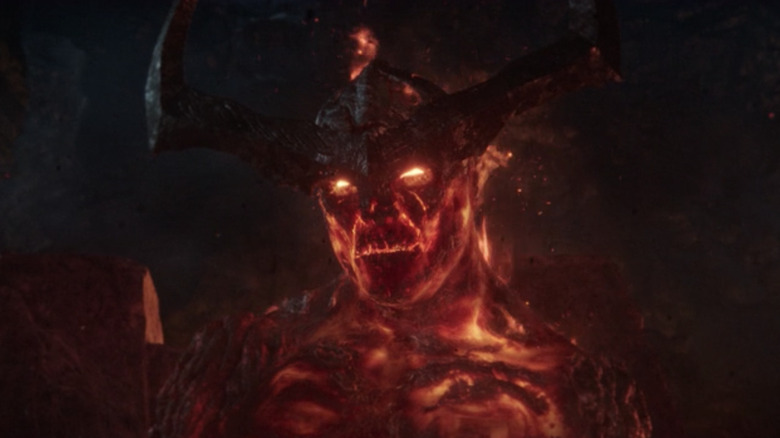Kevin Feige Reveals The Comic Book Arc That Influenced The Gradual Rise Of Thanos In The MCU
Who remembers Surtur, the fiery demon voiced by Clancy Brown in "Thor: Ragnarok?" Director Taika Waititi mostly played the character for laughs as part of the destruction and reinvention of the "Thor" mythos in 2017. In the end, Surtur wasn't quite as serious or memorable a Marvel movie villain as Josh Brolin's Thanos, who enjoyed his own warped, genocidal version of the classic hero's journey the following year in "Avengers: Infinity War."
However, Surtur's comic book counterpart and the way he was slowly revealed in one landmark storyline was a big inspiration for the gradual debut of Thanos in the Marvel Cinematic Universe. Written and pencilled by legendary comics creator Walt Simonson, "The Surtur Saga" was a year-long arc that played out in the pages of "Thor," Vol. 1 #340-353, published by Marvel Comics. This mid-1980s story arc also featured the Dark Elf, Malekith, who would become his own movie villain in "Thor: The Dark World."
In the new book, "The Story of Marvel Studios: The Making of the Marvel Cinematic Universe," uber-producer Kevin Feige outlines how "The Surtur Saga" influenced "Avengers: Infinity War." He says:
"It's impossible to talk about Infinity War without talking about sowing seeds. And there's one thing that Walt Simonson did that was a huge influence on our approach to the Infinity Saga. He had this space field. And you just read DOOM-DOOM-DOOM.' You didn't know what it was. And then the story would continue."
'To Be Continued ...'
Comics have long employed serialized storytelling to keep readers coming back, month after month, and while most Marvel movies don't end with the words, "To Be Continued ..." (like, say, "Back to the Future II"), there's usually an implicit understanding that the heroes depicted will live on in another upcoming adventure. Sometimes, the movies will plant seeds that don't come to fruition until several films later.
Back in the day, the same thing was going on with "The Surtur Saga" and its ominous "DOOM-DOOM-DOOM," which carried over from one comic book to another. Feige continued:
"At the end of the next book? DOOM-DOOM-DOOM. This went on for issues and issues. Basically, maybe it was a year later, it's revealed as Surtur, forging his sword. I always thought, 'How cool would that be to do that over the course of a bunch of movies?' We didn't do it with Surtur, but that's basically what Thanos has been from The Avengers, Guardians, and Avengers: Age of Ultron."
A common complaint with some Marvel movies is that they spend too much time trying to set up the next movie instead of focusing on the narrative at hand. This can also make their plots less accessible to people who have not kept up with past movies. With "Avengers: Endgame" currently ranking as the second highest-grossing film of all time, however, Marvel is clearly doing something right; and there's no denying that its massive, multi-movie approach has had a pervasive influence on the would-be shared universes of other film studios.
"The Story of Marvel Studios: The Making of the Marvel Cinematic Universe" is available from booksellers now.

